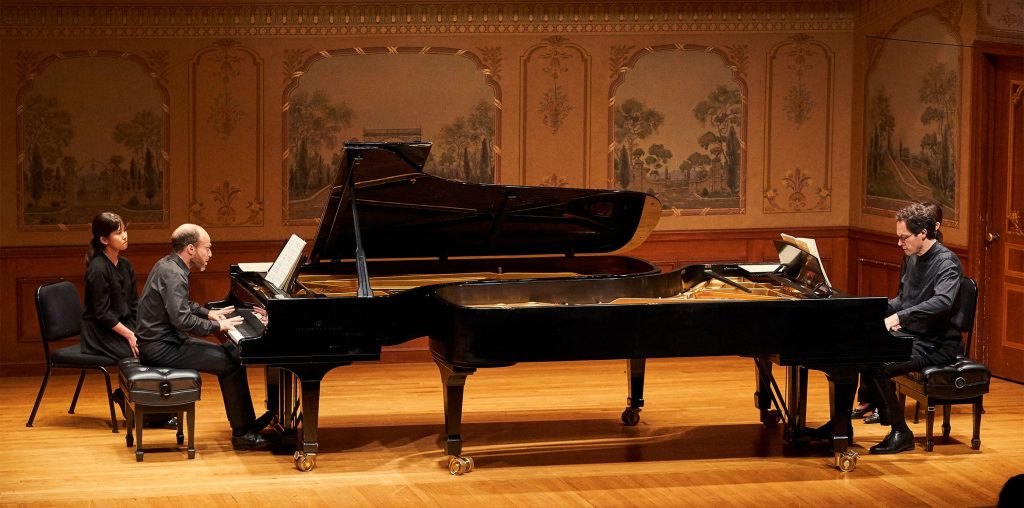An Introduction to the New “Two Piano/Four Hands” Feature of the Semi-Final Round
Guest blog post by music historian and performer, Anna O’Connell.
This year’s Cleveland international Piano Competition holds something very special in store: piano duos! This exciting new addition to the competition will provide semi-finalists an opportunity to be heard alongside their solo recital. The contestants will collaborate with each other, randomly assigned to play with a fellow contestant. Each must demonstrate not only the musicianship and acuity necessary to play the piece, but also their musicianship when performing with each other.
The contestants will be assigned one of two pieces: Schubert’s Fantasie in F Minor, D. 940 or Mozart’s Sonata for Two Pianos in D Major, K. 488. Each of these pieces is a seminal work for piano duo, but in slightly separate categories which we will explore below: Schubert’s piece is for “Piano Four-Hands,” while Mozart’s is for “Two Pianos.”
Piano Four Hands

Pieces composed for “piano four-hands”, are pieces for two people seated at one piano. As you can see in the video below, Leonid Hambro is seated at the lower end of the piano, while Victor Borge, is in front of the higher keys. Instead of a soloist with two hands having the function of left hand bass/accompaniment, right hand melody, in a four-handed situation, the person seated to the left would play the lower notes, and the person on the right would have more access to the higher melody notes. Except, as you can also see in this video, sometimes the parts are written to interlace the hands at some point. So musical function is not always so clear cut as which notes are right in front of you: some compromises must be made!
Franz Schubert composed a great number of piano four hands to be played with his students, such as Caroline Esterhazy, a noble woman he retained feelings for, and to whom his Fantasie in F Minor is dedicated. (There are occasional moments of scandalous closeness for the pianists’ hands!) In Schubert’s Fantasie in F Minor, D. 940, the person seated on the left plays accompaniment to the person seated on the right, whose melodies must go higher up the keyboard as the lower melodies surge up the piano (and vice versa).
Due to physical distancing requirements for this summer’s competition, you will see our contestants performing the Schubert on two pianos, rather than sharing a bench. Even though our contestants will be on two pianos, you will notice that one person is mostly playing on the lower end of the piano, and the other is mostly playing on the higher notes.
Two Pianos
Pieces for two pianos are often played by nestling two pianos together, so that the performers can look out over the sea of strings and golden piano innards to keep eye contact. As with any chamber music performing experience, it is critical for musicians to be able to sense each other to maintain an even idea of rhythm and general togetherness. While on some instruments it might be less obvious if the performers aren’t exactly together, the piano’s percussive nature means that the sound of each note is created by a precise attack when the hammer strikes the string. If those impulses don’t sound at the same time it becomes rather obvious, and it would potentially detract from the music making.

Historically, one of the first composers to compose for multiple keyboard instruments is J.S. Bach, who composed three concertos for two harpsichords. These chamber music works also included other instrumentalists, and harpsichord keyboards did not have the full range of the modern-day piano, and so they would have been rather different from the repertoire we shall hear. After Mozart, the piano duo repertoire began to include transcriptions of orchestral works, transcriptions of the orchestral parts for piano concertos, and even reductions of whole symphonies or other musical works into the nineteenth century. Johannes Brahms famously created and published a two-piano version of the German Requiem so that admirers of his work could enjoy it in the comfort of their own living rooms in an era before widespread music recording. And it is in the living rooms and salons that some of these piano duos came to find their place, as their own repertoire in newly composed works in addition to transcriptions or reductions of operas or other orchestral pieces.
Mozart composed several pieces for two pianos. In a two-piano situation, each performer typically has access to a full piano, and so could play the same notes at the same time, if the composer intended it that way. In Mozart’s D Major sonata for two pianos, Mozart scores the two pianos similarly, such that the pianists sometimes play in the same range, which is not possible in piano four-hand music. A challenge for musicians is maintaining a sense of balance between the two instruments as well as sharing and trading musical ideas, such that it sounds like one unified whole, rather than two simultaneous interpretations.
We hope you enjoy this exciting new feature of the Cleveland International Piano Competition!

